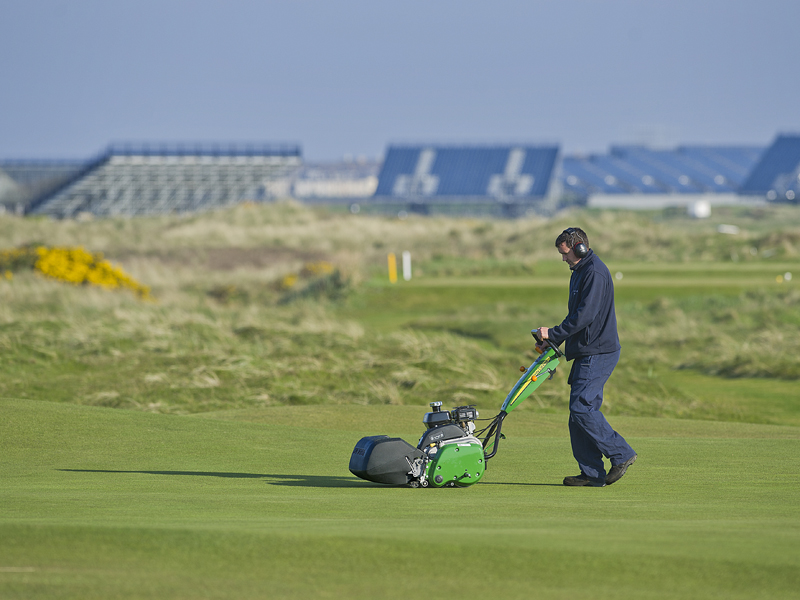'We've Been Closed For Almost Six Weeks Already This Winter, I've Never Known Anything Like It' - A British Greenkeeper On Battling Tough Conditions, Being Appreciated, And Finding The Next Generation
Rob Duval - who is the head greenkeeper at Scraptoft Golf Club in Leicestershire, England - tells Golf Monthly all about the challenges of the job and what golfers can do to help with course maintenance


For the thousands of greenkeepers across Britain and Ireland, carrying out their respective jobs over the harsh winter months can be an extremely difficult task. There is an increased amount of rain fall, the winds pick up, and the temperatures plummet - all while many of the more hardy players continue to brave the elements and demand to play whenever they choose.
But what is it like for the people whose job it is to take care of the hallowed turf at the 3,500-plus throughout the British Isles? How have they coped with the increased demand? And what are the biggest challenges when the nastiest weather hits? Do they simply keep their fingers crossed that the weather is just kind enough to prevent any disasters or are preventative measure taken? And how can you help?
Golf Monthly spoke to a member of the British and International Golf Greenkeepers Association (BIGGA) - Rob Duval, the head greenkeeper at Scraptoft Golf Club in Leicestershire - to find out the answers to some of the aforementioned questions.
GM: Firstly, how have you been dealing with the tricky conditions so far this winter?
RD: I mean, it’s been extremely challenging. The amount of rainfall that we've experienced this year, especially, it's just been astronomical. I've been working at Scraptoft for nearly 24 years and I've never known it closed for this amount of time. We've been closed for almost six weeks this winter already, which is just unheard of. And it creates so many challenges when it’s this wet.
"You're well aware of golfers wanting to get out and utilize the course, and we want to give them that while being able to present the course as well as possible. But when it’s wet, you simply can’t get any machinery out there to do anything."
GM: Do you need lots of money to do the job well or is it about skills and training?
Subscribe to the Golf Monthly newsletter to stay up to date with all the latest tour news, equipment news, reviews, head-to-heads and buyer’s guides from our team of experienced experts.
RD: "I think most greenkeepers are quite adaptable and, no matter what the conditions are, they give their members the best golf course that they can. But, ultimately, if the funds aren't there then you can't do it. You need the tools in order to create what people want."

GM: Do you think golfers appreciate what you do?
RD: "As far as golfers appreciating what we do and understanding the amount of work involved is concerned, I think it is getting better. With the likes of yourself and social-media platforms, green keepers are able to express and show exactly what goes into maintaining a course during the winter and the level of attention to detail that it takes to deal with abnormal playing conditions.
"If you go back - say 10 years - winter golf was winter golf and people dealt with it, whereas now, people are expecting 12 months of being able to play golf on a relatively high-standard course - and it is very, very hard to be able to deliver that."
GM: How can golfers play their part in helping greenkeepers? Repairing pitch marks properly, for example?
RD: "Everyone learning to do things properly like repairing pitch marks is an all-year-round thing. I don’t want to say it needs re-introducing, but there seems to be a lack of etiquette towards the golf course in some cases - and I think that needs promoting again. I’m not quite sure how we do that, but that general golf-course etiquette needs to improve again.
"Most golf courses throughout the winter have either just a painted white line or a rope to control traffic, and that’s done for a reason. It’s to control compaction around the greens so that everyone has a better experience in the summer months. But quite a lot of golfers choose to ignore it, which is a shame. If everyone could try and adhere to those measures a bit more, that would help, too."

GM: Have you been able to recruit well enough? How easy is it to recruit new greenkeepers?
RD: "There’s definitely a problem there. In terms of recruitment, we’ve really, really struggled to get hold of anybody. There's a shortage of greenkeepers, definitely, and what we end up doing is making do with inexperienced staff and trying to get by with a smaller team. So, I think, it's a real issue within the greenkeeping industry, recruitment.
"There's not enough people coming into the industry. The days of junior members coming in and just helping out for a summer - they seem to have gone - and that’s essentially how I got into it.
"BIGGA are launching a program called ‘First Greens’ where a local school will come up to visit us, and we’ll show them what it’s like to work within golf. But that’s all aspects, not just with greenkeeping. That’s a great initiative that BIGGA are running, and hopefully that will help."

Jonny Leighfield is our Staff News Writer who joined Golf Monthly just in time for the 2023 Solheim Cup and Ryder Cup. He graduated from the University of Brighton with a degree in Sport Journalism in 2017 and spent almost five years as the sole sports reporter at his local newspaper. During his time with Golf Monthly, Jonny has interviewed several stars of the game, including Robert MacIntyre, Ian Poulter, Lee Westwood, and Joaquin Niemann. An improving golfer himself, Jonny enjoys learning as much about the game as he can and recently reached his Handicap goal of 18 for the first time.